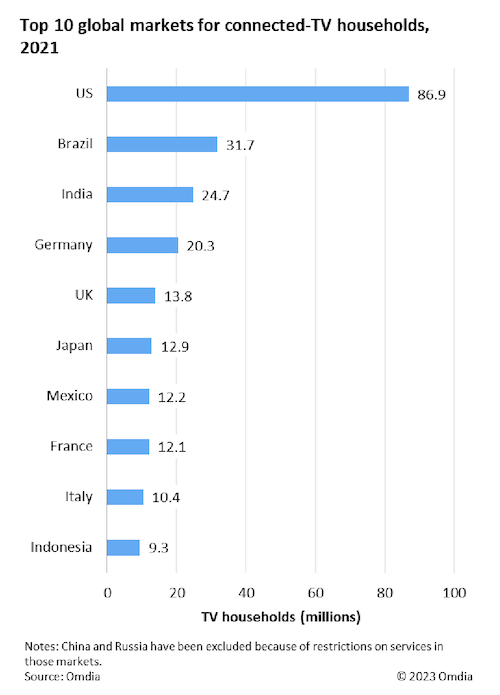
After more than 35 years of operation, TBI is closing its doors and our website will no longer be updated daily. Thank you for all of your support.
TBI Tech & Analysis: Breaking down FAST models, who’s watching & where
Free Ad Supported Television (FAST) channels have blossomed in the US over the past 18 months and all eyes are now on the rest of the world to see if that growth can be replicated elsewhere. Omdia’s Tim Westcott & Ed Ludlow break down business models, who’s watching & where.
FAST channels are commanding an increasing amount of attention from channel operators, programme distributors and consumer electronics manufacturers with Europe, Latin America, and Asia following the lead of the US, the most developed FAST market.
Channels are seeing consumer take-up, especially among younger viewers, as an alternative option to on demand. In some ways, they are a throwback to the classic TV model: curated and scheduled content.
However, they are more closely targeted, with many channels devoted to a single title.
Content has typically been through several distribution cycles and is often nonexclusive. As the market develops, weaker channel propositions are being replaced by more premium content. Although most channels are available across multiple platforms, operators such as Samsung are now offering exclusive FAST channels, available only to their users.
What is the FAST channel business model?
Business models for FAST channels typically fall into three main types: revenue share, inventory share, or flat fee.
- Revenue-share – the platform owner is responsible for selling
advertising inventory and agrees to pay a share to the channel provider. This is usually split 60/40 in favour of the channel provider, although this model was described as “outdated” by one executive at MIPCOM last year, and 55/45 or 50/50 splits are becoming more common - Inventory share – the dominant model in the US market, according to one major operator interviewed by Omdia. The channel owner allocates some of the advertising spots to sell itself. In both inventory and revenue share models, part of the ad revenue will go to the technology partner
- Flat-fee – the channel or content owner agrees to provide its content to the platform in return for an agreed annual fee. This is a less common model. One channel owner Omdia spoke to was offered a fee of $500,000 for six months by one platform
Where is FAST & who’s watching?
The US market is considered to be three to four years ahead of the rest of the world with regard to FAST.
Further south, Paramount’s Pluto TV launched in Latin America in 2020 and Brazil is seen as a hot prospect, but the European ‘big five’ are likely to be the next major growth area for FAST. ITV Studios was among numerous rights holders to launch channels here last year with a Hell’s Kitchen offering and Storylands, the latter stocked with dramas such as Masontonio from Italy and Norwegian legal series Aber Bergen.
Pluto TV has also launched in the Nordic region in partnership with Viaplay, while India boasts high penetration but low monetisation.In terms of those watching, Omdia’s consumer research suggests that FAST audiences skew slightly younger than those of other online and pay-TV services.
As of 2Q22, 45% of respondents that claimed to use FAST services in the US were under the age of 35. Only 13% of FAST users are from the 55‒64 age group, which made up 21% of respondents.
FAST audiences are also less likely to be in families: just 34% of users claim to live with children, in contrast to 42% of the general population, while 18% of users live alone, versus the national average of 14%. Over one-third is, however, a big enough proportion of the audience for most services to carry FAST channels aimed at children.
Other findings include 54% of the FAST audience being male – this trend is especially pronounced on the television-based FAST platforms: LG Channels and Samsung TV Plus male viewership both index at around 66%, for example.
However, income and wealth does not seem to have a massive influence on usage, though there is a slight but noticeable uptick in FAST users in wealthier demographics. FAST users over index in four of the five highest-earning brackets for respondents in the US.
The extract above is from Omdia’s FAST Channels Status Report: Content and Key Players, written by senior principal analyst, Tim Westcott and Ed Ludlow, senior data analyst. It is available here (via subscription).




